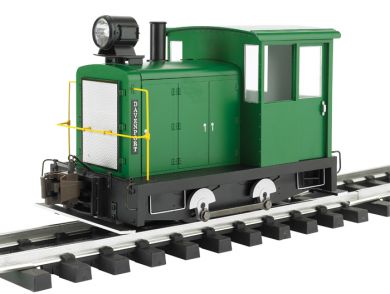Choo-Choo is back in town for the winter and he has brought some great Bachmann products for us to see. He loaned me a new Bachmann Davenport loco to try out and do a review on. This is a model in 1:20.3 of a Davenport 25 ton gas-mechanical locomotive. While it does not exactly match photos that I have, it is close. In fact it is similar to a 25 ton unit used on the D&RGW 3 foot gauge lines (#50) which shows up in the Second Diesel Spotters Guide, and is considered to be of pre-war vintage.
The locomotive measures about 8 inches long and 3 3/4 inches wide. It will be perfect pulling mine cars, four wheel flats, or even some log disconnects. These locomotives were generally used in industrial areas, and would be dwarfed by narrow gauge box cars and locomotives.
The locomotive comes with a smoke unit, working headlight (directional) Bachmann knuckle couplers and sliding doors on the cab. Rivet detail on this locomotive is good, and the diamond tread on the walkways adds to the realistic look. Handrails and steps are metal, along with the working coupler lift bars. The Davenport name plate has raised painted letters instead of just printed letters. A direct replacement by Kadee #830 couplers is simple, but it will be harder to add Accucraft couplers due to the thickness of the frame which is metal.
The locomotive comes in a variety of colors which includes red, green, yellow, silver and black. There is no lettering on the locomotive so that you can add your own for a particular railroad or industry.
The locomotive is a smooth runner with both axels powered. While there is not a lot of room for batteries in the body, a 7.2 Volt battery pack would fit and would give you a top speed of 10 scale miles per hour, which would be prototypical for this locomotive. The locomotive comes with a DCC ready control board located under the removable hood. On this board you will find a switch to control the smoke unit as well as a three position switch to control polarity (Large Scale Standard or NMRA.) There is an opening in the floor in front of the weights for a 1.5 inch speaker. Surprisingly, there is space below the PC board for a sound system card. In order to set this locomotive up for R/C control with batteries, the PC board must be removed completely, in order to fit batteries, control board, and sound card.
As I previously stated, the locomotive is a smooth runner. It crawls at 1.7 Volts, and will pull around 13 freight cars on a straight level track. I would replace the headlight with a smaller one, which is more prototypical, and replace the yellow LED with a warm white one as I did on my 2-8-0. I would also dig through my scarp box and find a horn to mount on the cab roof or hood, and maybe even a bell. I would also add wiper blades on the front and rear cab windows. A figure could be easily placed in the cab where a swivel chair and control station is provided. Since this locomotive is an industrial switcher, only one crew member would be needed. If this were lettered and used as an industrial locomotive, it would be weathered and rusted heavily, since constant use would prevent it from going into the paint shop.
I was impressed by this locomotive. It would really lend itself to many customizations and would fit in with 1:22.5 and 1:24 rolling stock as well as it's intended 1:20.3 scale. Thanks again to Choo-Choo for lending it to me.

